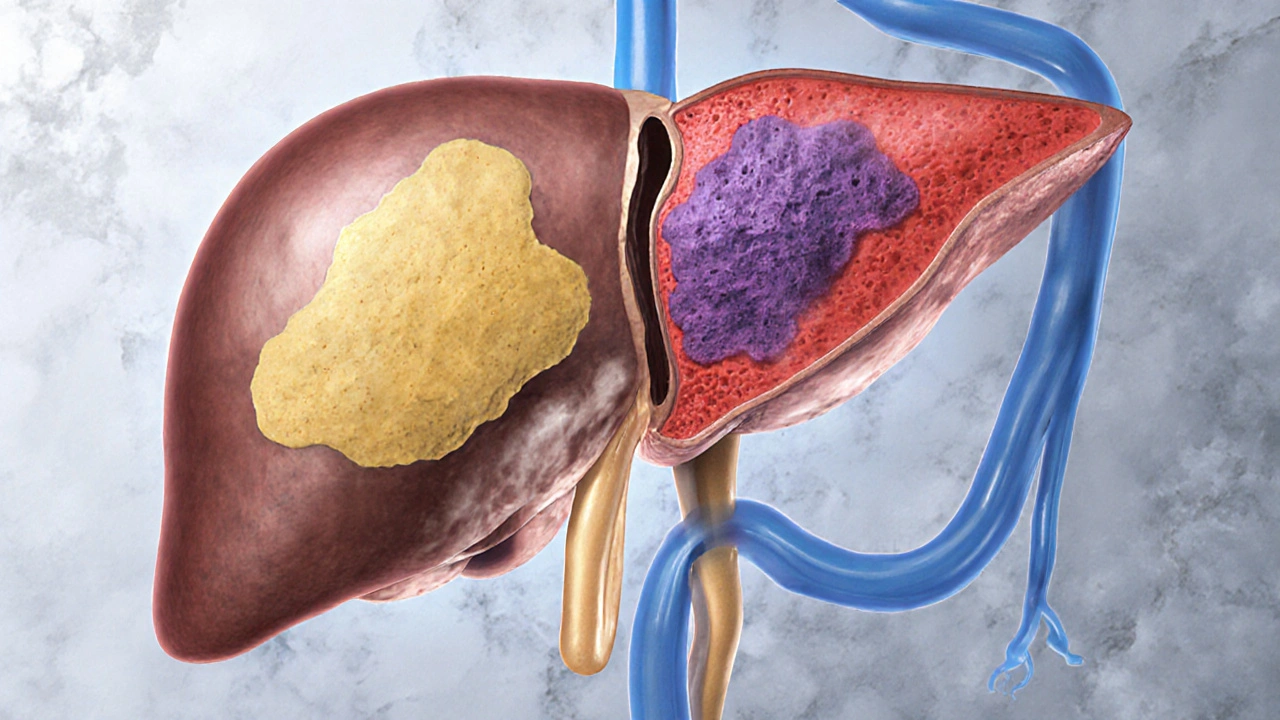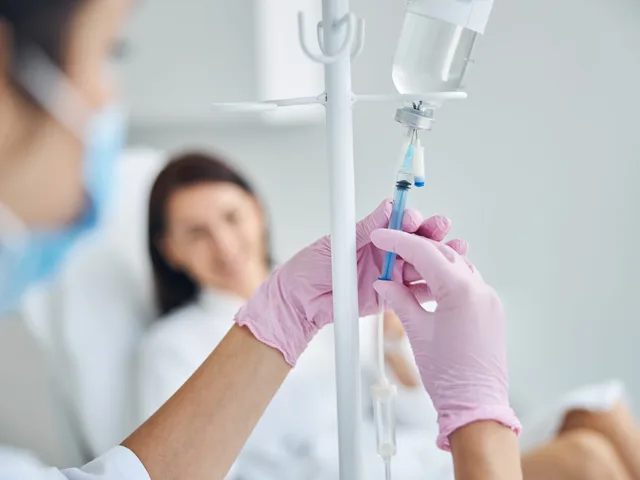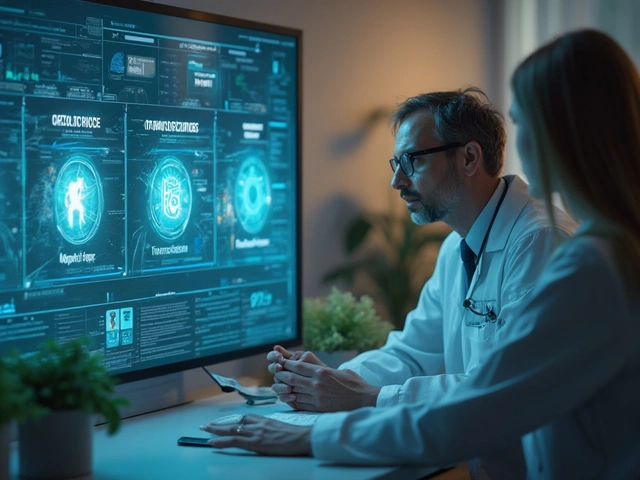Liver Pain Symptom Checker
Potential Liver Condition:
Symptom Match:
Recommendation:
When a sharp, relentless ache settles in the upper belly, most people think of indigestion, ulcers, or a stressed stomach. But that pain can also be the body’s alarm bell for something happening inside the liver.
Severe stomach pain is intense or persistent pain in the upper abdomen that often radiates to the back or shoulder. Liver disease refers to any condition that impairs the liver’s ability to filter blood, produce proteins, or process toxins. Understanding how these two health issues intersect helps you decide when a stomachache is just a nuisance and when it’s a call for medical attention.TL;DR - Quick Takeaways
- Upper‑right abdominal pain, especially if it worsens after meals, often points to liver or bile‑duct trouble.
- Common liver culprits include hepatitis, cirrhosis, fatty liver disease, liver cancer, and bile‑duct blockage.
- Accompanying signs-jaundice, unexplained weight loss, swelling, or dark urine-strengthen the link to liver disease.
- Blood tests (ALT, AST, ALP, bilirubin) and imaging (ultrasound, CT, MRI) are the standard diagnostic steps.
- If pain is severe, persistent, or paired with any liver‑related symptom, seek a doctor within 24‑48hours.
Why Liver Problems Can Cause Upper‑Abdominal Pain
The liver sits just under the rib cage on the right side of the body. When it inflames, enlarges, or develops a mass, it stretches the thin capsule (Glisson’s capsule) that covers it. That capsule is richly supplied with pain‑sensing nerves, so any tension or irritation translates into a deep, often “stabbing” sensation.
Additionally, the liver shares blood flow and bile pathways with the gallbladder and pancreas. Blocked bile ducts or a swollen gallbladder can create a pressure cascade that feeds back to the liver, amplifying the pain.
Common Liver Conditions Linked to Severe Stomach Pain
Below are the liver‑related illnesses most likely to generate noticeable abdominal discomfort.
Hepatitis is inflammation of the liver commonly caused by viruses (A, B, C), alcohol, or certain medications. The inflammation enlarges the organ, stretching its capsule and often producing a dull, aching pain in the right upper quadrant that can become sharp after a heavy meal. Cirrhosis describes advanced scarring of liver tissue that replaces healthy cells, usually from long‑term alcohol abuse or chronic viral hepatitis. Scar tissue limits liver flexibility, leading to constant pressure on the capsule. Patients often describe a “full‑bodied” pain that worsens with activity or when lying flat. Non‑alcoholic fatty liver disease (NAFLD) is a buildup of fat in liver cells unrelated to alcohol consumption, frequently tied to obesity and type‑2 diabetes. Early NAFLD may be silent, but as fat accumulates it can cause mild to moderate upper‑right discomfort, especially after fatty meals. Liver cancer (hepatocellular carcinoma) is a malignant tumor that often develops in cirrhotic livers. Tumors create localized pressure, producing persistent, sometimes radiating pain that does not ease with typical antacids. Bile duct obstruction occurs when stones, strictures, or tumors block the flow of bile from the liver to the intestine. The resulting back‑pressure can cause sharp, colicky pain that flashes to the right shoulder blade. Gallbladder disease (e.g., cholelithiasis) often co‑exists with liver issues because both share the biliary tree. Gallstones can block the cystic duct, producing a pain pattern that mimics liver‑related pain.How to Differentiate Liver‑Related Pain from Other Causes
Not every stomach ache means liver trouble. Here’s a quick decision guide:
- Location: Liver pain is usually felt high under the right rib cage. Pain centered around the belly button or lower abdomen points more to gastrointestinal issues.
- Radiation: A dull ache that shoots to the right shoulder or back is classic for liver or bile‑duct problems.
- Timing: Pain that worsens after fatty meals, alcohol, or prolonged fasting often signals a liver‑biliary link.
- Associated signs: Yellowing of the skin or eyes (jaundice), dark urine, pale stools, unexplained swelling (ascites), or a sudden weight loss are red flags for liver disease.
If you notice any of these patterns, it’s time to move beyond home remedies.

Diagnostic Pathway: What Doctors Look For
When you present with severe stomach pain, a clinician will typically follow this roadmap:
- Medical history: Alcohol use, medication list, travel, family liver disease.
- Physical exam: Palpation of the liver edge, check for tenderness, and look for jaundice or spider angiomata.
- Blood panel: Liver enzymes (ALT, AST), alkaline phosphatase, bilirubin, albumin, clotting profile (INR).
- Imaging: Abdominal ultrasound is the first‑line tool; CT or MRI follows if a mass or obstruction is suspected.
- Special tests: Hepatitis serology, FibroScan for liver stiffness, or biopsy when cancer is a concern.
These steps help pinpoint whether the pain originates from liver inflammation, scarring, fatty infiltration, or an obstructive process.
Management Strategies & When to Seek Immediate Care
Treatment hinges on the underlying cause:
- Viral hepatitis: Antiviral meds (e.g., sofosbuvir for HCV) plus lifestyle changes.
- Cirrhosis: Alcohol cessation, diuretics for fluid buildup, and screening for varices.
- NAFLD: Weight loss, dietary tweaks (Mediterranean diet), and exercise.
- Liver cancer: Surgical resection, ablation, or targeted therapies.
- Bile‑duct blockage: Endoscopic removal of stones or stenting of strictures.
Regardless of the diagnosis, severe or worsening pain that interferes with daily activities, causes vomiting, or is accompanied by fever or confusion demands urgent evaluation-ideally at an emergency department.
Quick Reference Comparison Table
| Condition | Typical Pain Location | Pain Character | Accompanying Signs |
|---|---|---|---|
| Hepatitis | Right upper quadrant | Dull ache, worsens after meals | Jaundice, fatigue, elevated ALT/AST |
| Cirrhosis | Right upper quadrant, may radiate to back | Constant pressure, worsens when lying flat | Ascites, spider angiomata, low albumin |
| NAFLD | Upper abdomen, often mid‑line | Mild to moderate ache, post‑prandial | Obesity, insulin resistance, mildly raised ALT |
| Liver cancer | Right upper quadrant, can be localized | Persistent, sharp, unrelieved by rest | Weight loss, night sweats, abnormal imaging |
| Bile duct obstruction | Right upper quadrant, may spread to shoulder | Colicky, episodic spikes | Jaundice, dark urine, pale stools |
Frequently Asked Questions
Can a simple ulcer cause pain that feels like liver disease?
Ulcers usually sit in the stomach or duodenum and cause a burning sensation that improves with antacids. Liver‑related pain is deeper, steadier, and often radiates to the right shoulder, so the two feel quite different.
Is it normal for liver pain to come and go?
Mild inflammation, such as early hepatitis, can produce intermittent aches that flare after alcohol or fatty meals. Persistent or worsening pain, however, warrants prompt medical review.
Do blood tests always detect liver disease when I have stomach pain?
Basic liver panels catch most active inflammation or blockage, but early fatty liver or small tumors may show normal enzymes. Imaging is then the next key step.
What lifestyle changes help reduce liver‑related abdominal pain?
Cutting alcohol, adopting a Mediterranean diet, losing 5-10% body weight, and regular aerobic exercise lower liver inflammation and often ease the pain.
When should I go to the emergency department for stomach pain?
If the pain is severe and sudden, accompanied by fever, vomiting, confusion, jaundice, or you notice your abdomen swelling, seek emergency care immediately.
Takeaway
Severe stomach pain isn’t just a gut issue-it can be the first clue that the liver is under stress. By paying attention to where the pain lives, what other symptoms appear, and how quickly it escalates, you can decide whether a simple remedy will do or whether a doctor’s evaluation is needed. Early detection of liver disease improves outcomes, so treat persistent upper‑right pain with the seriousness it deserves.





Anna-Lisa Hagley
October 1, 2025 AT 23:47While the piece is thorough, it tends to overstate how often severe upper‑right pain signifies liver disease; in primary care we see the majority of such discomfort stem from gallbladder or even musculoskeletal sources.
A Walton Smith
October 2, 2025 AT 00:20Sounds like typical gastro stuff.
Theunis Oliphant
October 2, 2025 AT 01:10One must recognize the subtlety of hepatic presentations; the liver, cloaked in a fibrous capsule, will not scream its distress without a motive, yet the lay reader often confuses transient dyspepsia with a portent of cirrhosis. The article rightly lists the red flags, but it neglects to caution that occasional post‑prandial ache may merely reflect a fatty meal overload.
India Digerida Para Occidente
October 2, 2025 AT 02:17Let us put the focus on practical steps: if you notice a persistent right‑upper quadrant ache that worsens after a greasy dinner and you also see a yellow tinge to your eyes, schedule labs without delay. Early imaging can differentiate between simple biliary colic and a more ominous hepatic lesion.
Andrew Stevenson
October 2, 2025 AT 03:24From a hepatology standpoint, the integration of ALT/AST ratios with imaging modalities such as transient elastography offers a non‑invasive pathway to stratify risk, thereby sparing patients unnecessary biopsies while still flagging those who need urgent intervention.
Hannah M
October 2, 2025 AT 04:30Hey, I totally get the anxiety when that sharp ache hits after a burger 🍔-just remember, a quick check‑up can rule out serious liver issues and give you peace of mind 😊.
Yareli Gonzalez
October 2, 2025 AT 05:37Remember, adjusting your diet to include more leafy greens and reducing alcohol can lower the frequency of liver‑related discomfort over time.
Carl Mitchel
October 2, 2025 AT 06:44It is irresponsible to ignore the warning signs of hepatic dysfunction; society must promote regular screening to prevent the cascade of preventable morbidity.
Josh SEBRING
October 2, 2025 AT 07:50Actually, many primary‑care clinicians would argue that a significant proportion of right‑upper quadrant pain does warrant early hepatic work‑up, especially given silent disease prevalence.
Lily Tung
October 2, 2025 AT 08:57The liver is an organ of remarkable regenerative capacity. Yet its symptoms are often cloaked in ambiguity. Upper right abdominal pain can emanate from a spectrum of causes. Simple indigestion, gallstones, muscular strain all share a common pain locale. When the capsule is stretched the brain registers a deep ache. Viral hepatitis inflames the tissue and adds a dull throb. Chronic alcohol abuse leads to fibrosis which produces a constant pressure. Non‑alcoholic fatty liver disease may cause intermittent discomfort after a fatty meal. Malignant lesions create a localized, sharp pressure that does not abate. Bile duct obstruction produces episodic colicky spikes that radiate to the shoulder. Laboratory panels reveal enzyme elevations that guide diagnosis. Imaging such as ultrasound can visualize organ enlargement or masses. Early detection improves therapeutic outcomes and reduces mortality. Lifestyle modifications including weight loss and abstinence from alcohol mitigate many of these conditions. Therefore, any persistent right‑upper quadrant pain should prompt a thorough medical evaluation without delay.
Taryn Bader
October 2, 2025 AT 10:04My heart aches at the thought of anyone ignoring such a warning; the pain becomes a tragic chorus in the body.
Myra Aguirre
October 2, 2025 AT 11:10Just a heads up that staying hydrated can help ease mild abdominal discomfort.
Shawn Towner
October 2, 2025 AT 12:17While jargon sounds impressive, most patients just need clear advice, not a lexicon of hepatic indices.